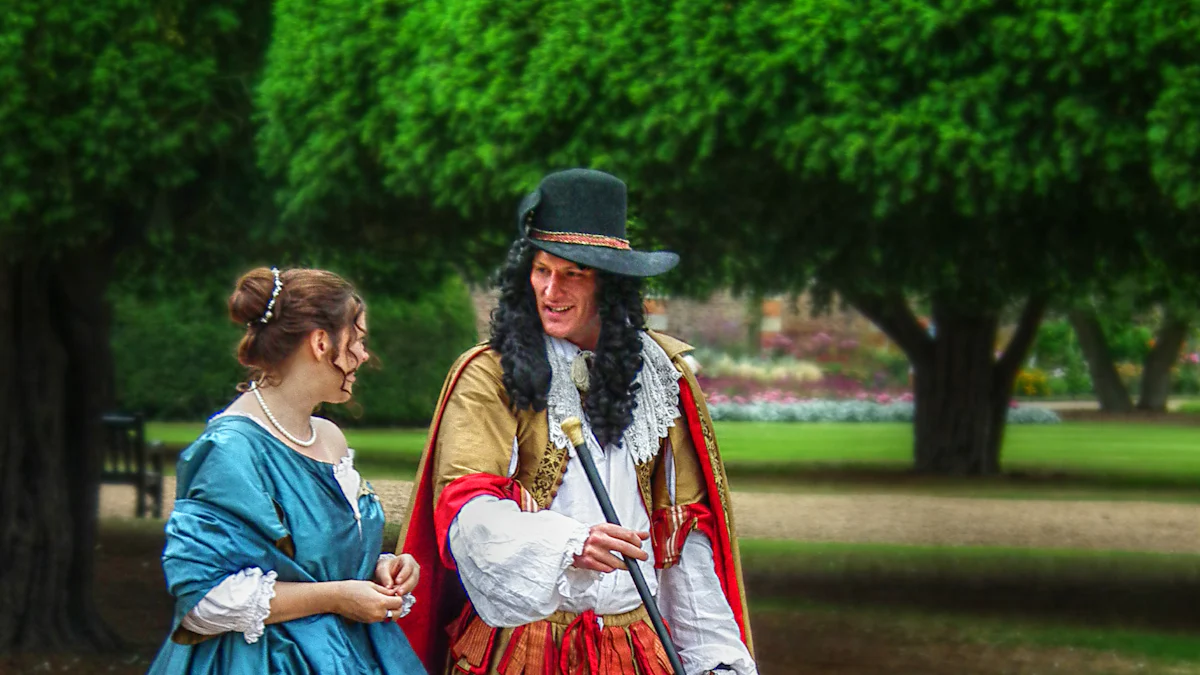 During the Renaissance era, fashion played a pivotal role in societal dynamics. The clothing choices of individuals not only reflected their status but also conveyed cultural norms and values. Renaissance women’s clothing, in particular, showcased a fascinating blend of opulence and practicality. From luxurious fabrics adorning royalty to simpler materials worn by commoners, attire spoke volumes about one’s place in society. Understanding these distinctions offers a glimpse into the intricate tapestry of Renaissance fashion evolution.
During the Renaissance era, fashion played a pivotal role in societal dynamics. The clothing choices of individuals not only reflected their status but also conveyed cultural norms and values. Renaissance women’s clothing, in particular, showcased a fascinating blend of opulence and practicality. From luxurious fabrics adorning royalty to simpler materials worn by commoners, attire spoke volumes about one’s place in society. Understanding these distinctions offers a glimpse into the intricate tapestry of Renaissance fashion evolution.
Renaissance Women’s Clothing: An Overview
Fabrics and Materials
In the Renaissance period, luxurious fabrics were a symbol of status and wealth for royalty. These opulent materials included silk, velvet, and satin, meticulously crafted to exude elegance and grandeur. The intricate designs and rich textures of these fabrics adorned royal garments with unparalleled splendor, showcasing the elite’s affluence and power.
On the other hand, commoners in society relied on more accessible materials for their clothing. Fabrics like wool, linen, and cotton were prevalent among the lower classes, reflecting practicality and simplicity in their attire. Despite not possessing the extravagance of royal textiles, commoner fabrics were durable and suited everyday wear, emphasizing functionality over luxury.
Colors and Dyes
The vibrant rich hues that adorned noblewomen’s garments during the Renaissance era were a sight to behold. Deep purples, regal blues, and crimson reds saturated royal attire with a sense of majesty and sophistication. These bold colors symbolized wealth and nobility, distinguishing the elite from the rest of society.
Conversely, natural tones dominated the color palette of common folk’s clothing. Earthy shades like browns, greens, and soft yellows characterized the attire of everyday individuals. These muted tones derived from natural dyes reflected simplicity and humility among the commoners, mirroring their modest lifestyles.
“Sumptuary laws in England during the Renaissance period regulated clothing materials and styles based on social class.”
Styles and Designs
Dresses and Gowns
When examining Renaissance women’s clothing, the distinction between royal dresses and commoner dresses becomes evident. Royal dresses were extravagant in design, featuring intricate embroidery and lavish embellishments that showcased the wearer’s noble status. These garments often boasted opulent fabrics like silk and velvet, tailored to perfection to accentuate the regal bearing of the wearer.
On the contrary, commoner dresses exuded simplicity and functionality. Crafted from more accessible materials such as wool and cotton, these garments prioritized comfort over luxury. Commoner attire was characterized by modest designs with minimal adornments, reflecting the practical lifestyle of individuals from lower social classes.
Sleeves and Necklines
The evolution of sleeve styles in Renaissance women’s fashion offers a glimpse into the sartorial preferences of the era. Sleeve styles varied between voluminous puffs and sleek, fitted silhouettes. Royal women often donned sleeves adorned with intricate lace or delicate embroidery, adding a touch of elegance to their ensembles.
Similarly, neckline variations played a crucial role in defining the overall look of Renaissance attire. High necklines were favored by royalty for their regal appearance, while commoners opted for more modest necklines that suited their everyday activities. The neckline served as a canvas for showcasing exquisite jewelry or intricate detailing, enhancing the visual appeal of the outfit.
“The diversity in dress styles during the Renaissance period reflects the societal hierarchy and cultural values prevalent at that time.”
Accessories and Adornments
Jewelry and Headpieces
Royal Jewelry
- Adorning oneself with extravagant jewels was a hallmark of nobility during the Renaissance period.
- Precious gemstones like rubies, emeralds, and sapphires embellished royal crowns and necklaces, symbolizing wealth and power.
- Intricately designed tiaras and ornate brooches were favored by noblewomen to enhance their regal attire.
Commoner Accessories
- For commoners, simple adornments were more prevalent in everyday wear.
- Copper or brass trinkets, wooden beads, and modest headscarves were typical accessories worn by individuals from lower social classes.
- These understated accessories complemented the humble attire of common folk, reflecting practicality over opulence.
Footwear and Cosmetics
Shoes and Boots
- Footwear choices varied greatly between royalty and commoners in Renaissance society.
- Noblewomen flaunted elegant shoes crafted from fine leather and adorned with intricate embroidery or metallic accents.
- In contrast, common women opted for sturdy leather boots or simple sandals suitable for their daily activities.
Use of Cosmetics
- The use of cosmetics was a significant aspect of Renaissance beauty standards for women across all social strata.
- Noblewomen indulged in elaborate makeup routines, using lead-based powders to achieve a pale complexion and enhancing their features with vibrant pigments.
- Common women embraced more natural looks, focusing on skincare remedies using herbs and oils to maintain a healthy glow.
“The stark contrast in jewelry styles and cosmetic practices between royalty and commoners underscored the societal hierarchy embedded in Renaissance fashion.”
Fashion during the Renaissance era served as a visual language, articulating societal hierarchies and cultural values. The distinct attire of royalty and commoners highlighted the stark contrasts in wealth and status. Clothing was not merely a covering but a statement of identity and power, reflecting the wearer’s place in society. As fashion continues to evolve, from Renaissance opulence to modern trends, it remains a testament to the enduring significance of personal expression through attire. The legacy of Renaissance fashion lives on, weaving together history, artistry, and individuality in every stitch.






